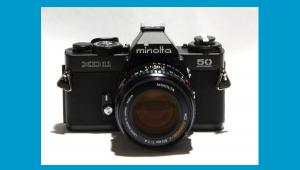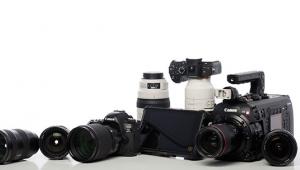User Classics: Motor Drives for Film Cameras
Various terms have been used to describe this accessory including motor drives, motor winders and autowinders. What's the difference? Generally speaking, motor drives are capable of using up your film at a higher rate of speed, most often measured in "frames per second" (fps). Most motor drives also have the ability to adjust the fps via a built-in selector switch. Many have a convenient hand grip as well. Some even have the ability to rewind your film automatically.
Motor winders and autowinders are two names that essentially refer to the same thing, the main difference being what the particular manufacturer decided to call them. They are typically smaller, lighter, less expensive and not as full featured as motor drives. For example, most do not have adjustable fps, grips or auto rewind.
Some common settings that may be found on many of the popular winders and motors are S, C, CL, and CH, or some similar variant. In the S mode, only a single frame will fire, the film will advance to the next frame, and then you will need to depress the shutter button again to shoot another frame. The C mode allows for continuous film advance for as long as you have the shutter button depressed. In this mode the typical firing rate is usually 1 to 1.5 fps. The CL setting refers to a continuous low firing rate--typically from 1.5 to 2.5 fps. The CH setting means continuous high--generally from 3 to 6 fps. The higher fps rates are generally used by serious photographers shooting sports or fast moving wildlife. At 6 fps you will go through a 36 exposure roll of film in only 6 seconds. At one time there was even a motor drive introduced that could fire at 14 fps. Imagine going through a roll of film in barely 2 seconds!
There are other factors that can affect the actual firing rate of your motor drive. One is the shutter speed you have set on your camera. Slower shutter speeds will, of course, potentially slow the effective fps setting on your motor. Another, perhaps less obvious factor, is the type and freshness of your batteries. If maximum firing speed is important, make absolutely certain that your batteries are fresh. Weak batteries may significantly reduce the performance of your equipment. Some models offer a choice of compatible battery types, such as alkaline, lithium, or nickel cadmium. Please consult the instruction manual or qualified personnel for the appropriate battery choices for your winder or motor drive. Using the wrong power source can result in irreparable damage to not only the motor, but possibly to the camera as well.
Some motor drives and winders were designed to fit on several different camera models. Likewise, certain specific cameras were designed to accept either a motor drive or an autowinder. To help you find the right motor drive for your manual advance film camera (if it has motor drive capability) first, of course, make sure it's matched to your brand and model, then check these buying tips:
1) Several third party manufacturers also made winders to
fit on the original equipment manufacturer's (OEM)camera bodies. These
should sell for substantially less than the corresponding unit offered by the
OEM.
2) Open the battery chamber of the motor / winder to check
for signs of corrosion around the battery contacts. Slight corrosion may be
fixed with a proper cleaning. Heavy corrosion may mean a bigger problem and
should be checked out by a certified repair technician.
3) Keep in mind that some older motor drives may require battery
packs that are no longer available new.
4) Ask permission to try out the motor / winder on your camera
before purchasing. If it has multiple fps selections, try them all. The dial
or switch should engage smoothly, without a gritty sound. If not, ask to see
another one if possible. Otherwise have it checked out by a certified repair
technician.
5) If you are purchasing by phone / mail / Internet, make certain
you are clear on the warranty and return policies in case you have trouble with
your purchase. Please refer to our mail order guide for more details on avoiding
unanticipated problems.
6) Do some price comparisons prior to contacting your dealer.
Items in better condition will usually command higher prices. Also if an item
is rare, expect to pay a premium.

















































